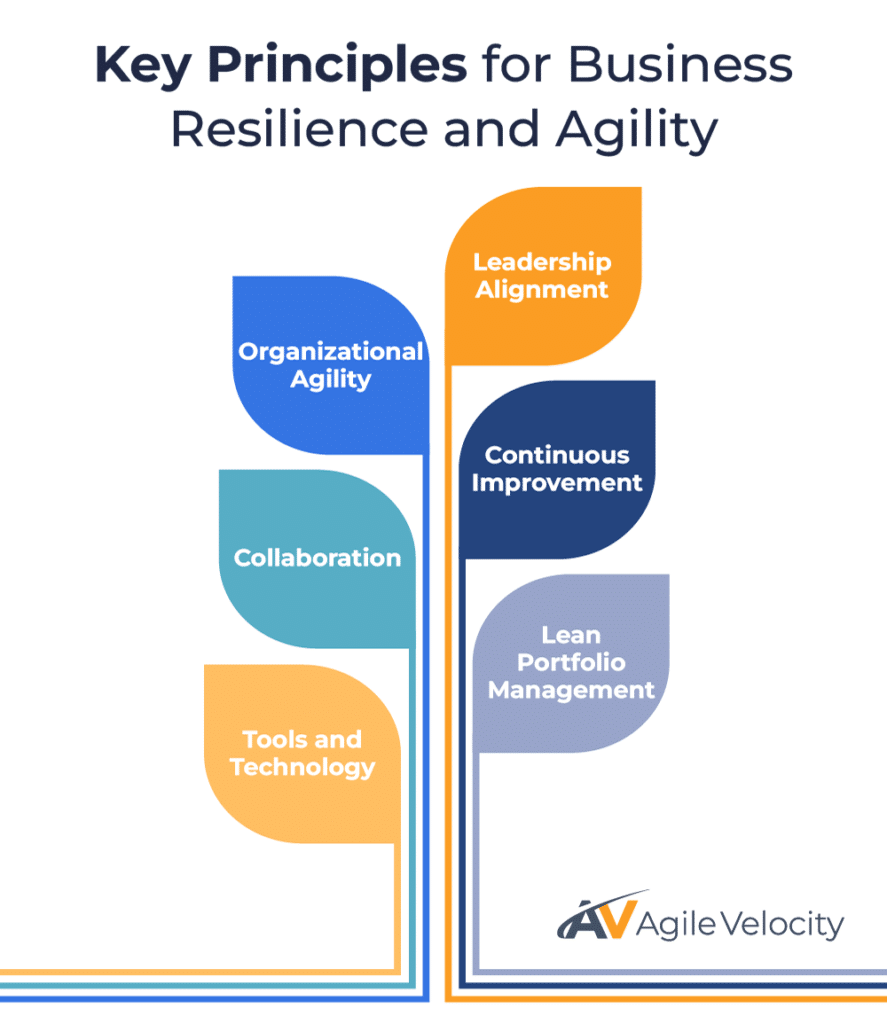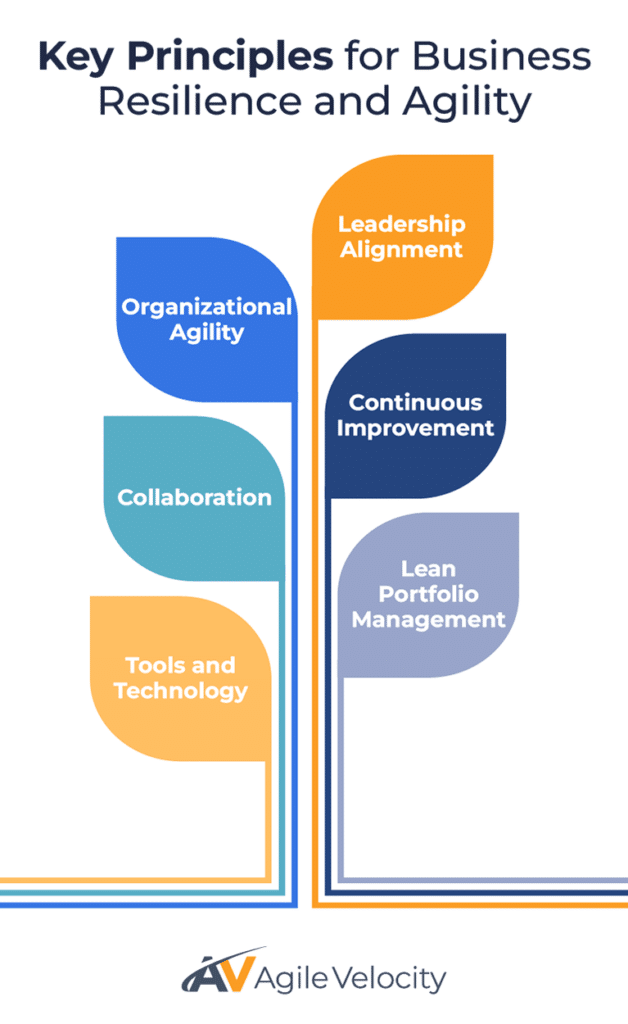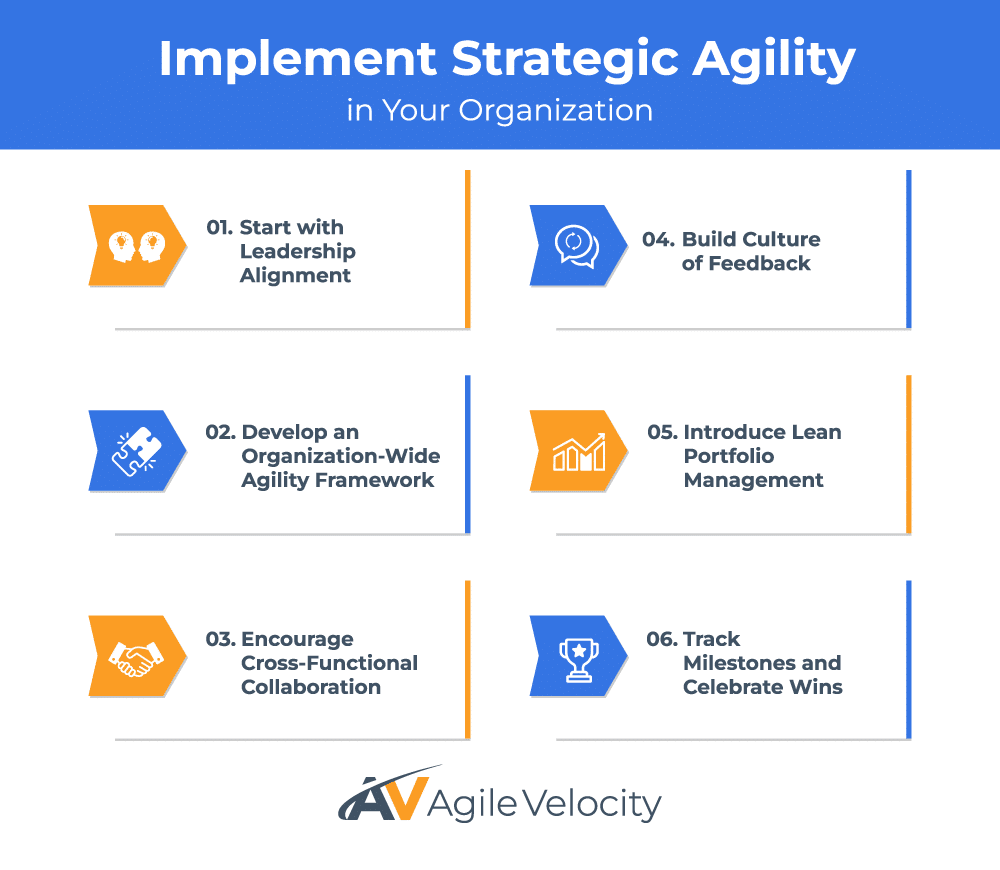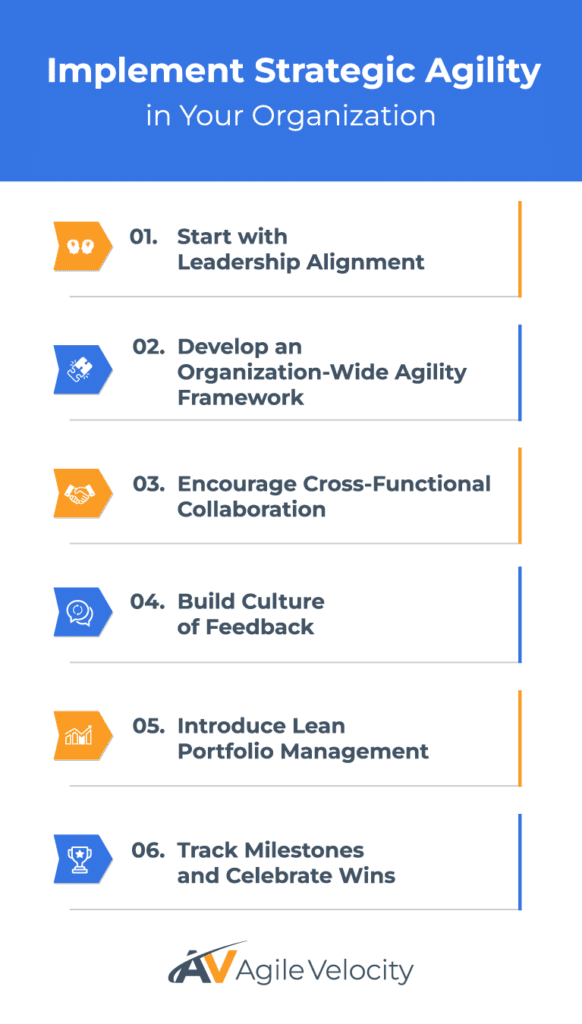Strategic agility has become essential for businesses aiming not only to survive, but also to thrive. The ability to make strategic, and sometimes large-scale pivots effectively in response to market shifts, disruptions, or evolving customer expectations is no longer optional. Organizations that prioritize agility empower themselves to stay relevant, proactive, and competitive, regardless of external challenges.
Strategic agility goes beyond one-off adjustments or efficiency improvements. It’s about building a culture of adaptability, where teams align behind clear goals and refine how work is delivered. At its core, this approach is about delivering long-term value and fostering resilience throughout the organization.
In this article, we’ll explore six foundational principles of strategic agility that enable businesses to adapt and grow. From aligning leadership to embedding agility at every level, cultivating continuous improvement, and harnessing technology like Path to Agility® Navigator, these principles provide a roadmap for organizations looking to navigate disruption with confidence. By adopting these practices, your organization can establish a firm platform for creating value and seizing future opportunities.
The Importance of Strategic Agility in Business Resilience
Strategic agility is the engine that propels an organization’s ability to respond to shifting business landscapes. Whether facing market changes, technological disruption, or evolving customer needs, companies equipped with flexibility and foresight can transform challenges into opportunities for growth.
Rather than relying on one-off crisis responses, strategic agility embraces long-term alignment and quick decision-making. It supports forward-looking strategies while allowing organizations to pivot effectively when necessary. Businesses that embed agility at their core more easily uncover new paths to success, stay ahead of competitors, and cultivate resilience across the board.
Strategic agility lays the groundwork for organizations to anticipate and weather disruptions. It promotes:
- Proactive, well-informed decisions guided by a balanced view of immediate and long-term goals.
- Open collaboration across departments, generating fresh ideas and efficient execution.
- Greater ownership and engagement, as teams see the direct impact of their work.
By committing to agility, businesses not only defend against external shocks, but also discover new venues for creating value. Alignment, collaboration, and a focus on continuous improvement encourage teams to respond confidently—no matter what lies ahead. The following sections outline six core principles that help organizations achieve strategic agility for lasting resilience.


Principle 1: Leadership Alignment
Strong leadership alignment is the foundation of strategic agility. When leaders share the same vision, they create clarity and purpose throughout the organization. Unified leadership communicates consistent priorities, supports cohesive decision-making, and keeps teams moving in the same direction—even in volatile conditions.
The Role of Leadership Alignment in Strategic Agility
Aligned leadership delivers clear, focused messages that include not only the “what” but also a compelling “why” guide everyone toward the same objectives. When circumstances shift, leaders who operate from the same playbook can respond faster without compromising long-range goals. A fractured leadership team, however, leads to miscommunication, contradictory priorities, and isolated silos that undermine agility.
When leaders stand together, team members see how their roles tie into the organization’s broader mission. This unified clarity fosters confidence, promotes coordinated action, and empowers teams to adapt quickly while staying on course.
Best Practices for Leadership Alignment
- Define a Clear Vision: Craft a concise mission that shapes decision-making and inspires team members.
- Encourage Transparent Communication: Leaders exchange ideas openly, surfacing concerns early to correct course and maintain unity.
- Model Expected Behaviors: Align actions with stated values, reinforcing trust across the organization.
- Revisit Alignment Regularly: Reassess shared goals and progress at scheduled intervals to address changing circumstances.
How Agile Velocity Supports Leadership Alignment
Agile Velocity’s team coaching and workshops aim to support leadership teams in enhancing collaboration, clarifying responsibilities, and aligning their goals. By uniting decision-makers around a common purpose, these programs establish a strong framework for strategic agility and empower teams to operate with consistent focus and direction.
Principle 2: Embedding Organizational Agility
Embedding organizational agility means extending adaptive practices across every department and function. It moves beyond a single team’s efficiency, aiming to reshape the entire way the business runs. When agility permeates the organization, teams can respond collectively to changes, sharing information and working toward a unified objective.
What Is Organizational Agility?
Organizational agility involves a company’s capacity to adjust promptly to shifting market conditions while keeping long-term aims in sight. It thrives on collaboration, learning, and adaptability at scale. Key elements include:
- Cross-Functional Coordination: Different teams share knowledge freely, align priorities, and tackle goals jointly.
- Adaptive Culture: Supports experimentation, learning, and refining practices over time.
- Visibility and Feedback: Real-time data collection informs decision-making and highlights improvement areas.
By embracing these attributes, organizations evolve effectively, delivering consistent value in dynamic scenarios.
Breaking Down Silos for Seamless Agility
Silos complicate communication and slow both decision-making and execution. Organizational agility requires dismantling silos so departments can align around shared goals. When teams work cohesively, the entire business can pivot faster, tap into broader expertise, and streamline outcomes.
Silo-free environments elevate transparency. Everyone understands how their work intersects with others, reducing redundancy and speeding up responses to emerging challenges.
Using Path to Agility Navigator to Enable Systemwide Agility
Tools like Path to Agility Navigator pinpoint inefficiencies and highlight needed changes. By collecting insights from leaders and teams, this platform offers data-driven clarity on where to focus improvements. It visually maps progress, ensuring everyone sees roadblocks and milestones.
Because the insights are detailed and actionable, teams can coordinate their efforts, driving meaningful change throughout the organization. This systemwide approach to agility enhances adaptability and readiness for future challenges.
Principle 3: Continuous Improvement as a Mindset
Continuous improvement underpins strategic agility. It’s an ethos that drives teams to refine their methods, ideas, and processes constantly. Rather than waiting for big revamps, an organization with a continuous improvement mindset pursues small, steady optimizations to keep pace with shifting conditions.
Why Continuous Improvement Drives Strategic Agility
Embracing continuous improvement gives businesses the freedom to evolve without losing sight of larger ambitions. It fosters:
- Innovation: Ongoing experimentation encourages creative thinking and paves the way for fresh opportunities.
- Reduced Risks: Incremental changes uncover issues early, preventing large-scale setbacks.
- Team Empowerment: Employees feel valued when their improvement ideas shape real-world outcomes, boosting engagement.
By normalizing continuous learning, organizations remain adaptable and make progress in manageable steps.
Effective Strategies to Encourage Continuous Improvement
- Hold Regular Retrospectives: Dedicate time after each project or cycle to review successes, identify growth areas, and implement learnings.
- Conduct Quick Experiments: Test ideas on a small scale before rolling them out more widely, minimizing risk and building momentum.
- Open Feedback Channels: Encourage honest critiques and diverse perspectives so teams can quickly spot and address blind spots.
- Reward Adaptability: Recognize both successful innovations and insights from challenges. This reinforces a culture of healthy risk-taking.
How Agile Velocity Elevates Continuous Improvement
Through specialized coaching and workshops, Agile Velocity helps teams integrate continuous improvement into daily operations. Their guidance fosters feedback loops and practical methods that drive consistent learning, optimized processes, and measurable gains in productivity—ultimately strengthening strategic agility.
Principle 4: Collaboration and Cross-Functional Excellence

Collaboration powers strategic agility by merging diverse expertise into cohesive action. True cross-functional excellence emerges when individuals from multiple departments exchange ideas, solve problems jointly, and propel shared objectives forward.
Why Collaboration Fuels Strategic Agility
Working across departments ensures issues are viewed from different angles, leading to more comprehensive solutions. By involving multiple voices at the outset, teams detect potential pitfalls early, streamline workflow, and reduce rework. Cross-functional collaboration encourages collective ownership, accelerating decision-making and adaptability.
Strengthening Cross-Functional Collaboration
- Unify Teams Around Common Goals: Link each department’s tasks to high-level business objectives.
- Encourage Regular Interactions: Hold structured sessions to review progress, surface problems, and identify collaboration opportunities.
- Rotate Initiative Leadership: Allow experts in different areas to spearhead projects, supporting mutual respect across domains.
- Maintain Safe Environments: Give people the freedom to raise new ideas and explore them in open forums without fear of criticism.
Agile Events as Collaboration Catalysts
Agile Methodologies offer events that bring various functions together such as:
- Daily Scrum: Short sessions where priorities are shared and assistance is offered.
- Sprint Review: Teams and stakeholders assess completed work and discuss improvements for the next iteration.
These events keep the organization synchronized, fueling effective, ongoing teamwork.
How Agile Velocity Fosters Cross-Functional Collaboration
Agile Velocity’s service offerings help companies improve communication and build a culture where cross-functional collaboration can thrive. Through strategies like skill mapping and business operations consulting, these programs focus on enabling open discussions, shared accountability, and mutual respect, helping teams adapt promptly to evolving requirements.
Principle 5: Aligning Work With Strategic Goals Through Lean Portfolio Management
Lean Portfolio Management (LPM) ties daily execution to the broader strategic vision. It keeps work purposeful, maximizes resource use, and delivers steady value by prioritizing initiatives that align with top-level business objectives.
Why Lean Portfolio Management is Essential for Strategic Agility
Unclear priorities lead to loss of focus, wasted efforts and lost time. Opportunity cost and the cost of context switching are real and significant. This Lean Portfolio Management approach ensures that all projects support concrete organizational goals. It optimizes resource distribution, balances immediate needs against future aspirations, and enables swift shifts when priorities change.
Key benefits of LPM include:
- Focused Prioritization: Targets the most impactful initiatives first.
- Visibility Across Portfolios: Helps leadership track progress, remove roadblocks, and maintain alignment.
- Flexible Resource Allocation: Makes it easier to pivot and reassign resources based on emerging business scenarios.
- Limiting Work in Progress: Keeping control on how many different initiatives are simultaneously in-progress creates an environment focused on continuous value delivery
Balancing Short-Term Wins and Long-Term Success
LPM ensures today’s urgent tasks don’t overshadow tomorrow’s opportunities. By regularly revisiting portfolios and adjusting plans, organizations can keep projects relevant without sacrificing innovation or strategic development.
Best Practices for Implementing Lean Portfolio Management
- Define Clear Themes: Articulate organizational priorities to guide portfolio decisions.
- Continuously Evaluate Projects: Check whether ongoing work still produces value, and pivot or stop initiatives as necessary.
- Encourage Transparent Communication: Leadership and delivery teams openly share changes, ensuring everyone remains aligned.
- Track Progress and Measurable Outcomes: Monitor results to gauge whether initiatives fulfill strategic aims.
How Agile Velocity Drives Success With Lean Portfolio Management
Agile Velocity’s expertise in LPM, combined with tools like Path to Agility Navigator, supports seamless alignment from strategy to execution. Their leading change in Agile Transformations insights help businesses establish the right structures for prioritizing initiatives, allocating resources effectively, and staying agile in unpredictable markets.
Principle 6: Harnessing Tools and Technology to Drive Adaptability
Strategic agility is enhanced by modern tools that streamline workflows, provide real-time visibility, and support data-driven decisions. The right technology empowers teams to adapt dynamically, focusing on work that creates tangible value.
Why Technology is Central to Agility
Well-chosen tools help a company move faster and smarter. A Kanban Board gives immediate insight into what work is ongoing, progress toward goals, and bottlenecks , preventing overloads and delays. Path to Agility Navigator highlights organizational hurdles, guiding leadership to important next steps in scaling agility.
By reducing guesswork and automating repetitive tasks, technology frees participants to concentrate on creativity, collaboration, and continuous learning—vital elements of a nimble organization.
The Growing Role of AI in Strategic Agility
AI reshapes agility by analyzing large data sets, offering accurate forecasts, and handling routine work. These automation gains let teams focus on more strategic problems. Still, implementing AI must align with clear goals and proper training to encourage adoption rather than resistance.
Best Practices for Implementing Tools and Technology
- Identify Specific Needs: Pinpoint efficiency gaps or bottlenecks before committing to new technology.
- Ensure Ease of Use: Choose user-friendly solutions applicable to your team’s skill level, supplemented by training.
- Integrate Smoothly: Select tools compatible with your existing processes to avoid duplicated effort.
- Measure Impact: Regularly review tool usage and outcomes, refining practices as the organization evolves.
- Foster Open Feedback: Collect user suggestions and make adjustments accordingly, increasing buy-in.
Path to Agility Navigator: A Game-Changer for Transformation
Path to Agility Navigator offers a visual transformation roadmap. It captures the progress of agility initiatives, uncovers bottlenecks, and steers teams toward the next steps. By making results transparent, this platform reinforces accountability and continuous alignment, ensuring agility efforts stay on track and deliver tangible outcomes.
When combined with a proactive mindset, these upgrades enhance a company’s ability to innovate, collaborate, and maintain consistent progress in uncertain conditions.
Request a Demo
Practical Steps to Build Strategic Agility
Building strategic agility involves not only understanding the key principles but also applying them meticulously across the organization. This process requires a commitment to fostering adaptability, encouraging innovation, and ensuring that every team aligns with ongoing strategic objectives. By actively incorporating these principles into your company’s DNA, you set the stage for enduring resilience and future success.
Below are strategies to help embed a culture of agility and resilience.


Start with Leadership Alignment
Convene leadership for collaborative goal-setting. Define a unifying vision that paves the way for future market changes. Schedule recurring check-ins to reassess priorities and ensure leaders remain on the same page.
Need additional roles to facilitate transformation? Consider Agile Velocity’s Agile Staffing service offering to fill skill gaps quickly.
Develop an Organization-Wide Agility Framework
Outline how each department will practice organizational agility. This can involve pilot programs, adopting Agile events like Sprints at scale, or cultivating interdepartmental projects. Such a framework unifies and systematizes agility across the business.
Encourage Cross-Functional Collaboration and Learning
Break down silos by arranging initiatives that foster knowledge-sharing—like shadowing or short-term cross-departmental projects. These exchanges spark fresh perspectives, strengthen relationships, and create shared accountability for success.
Build a Culture of Feedback and Iteration
Use Sprint Retrospectives or quick syncs to assess progress regularly. Encourage teams to voice what’s working and what needs revisiting. Iterative adjustments keep the organization evolving harmoniously.
Introduce Lean Portfolio Management Practices
Adopt LPM in stages, mapping out existing initiatives and prioritizing strategic ones. Even small-scale trials help demonstrate how aligning projects with top-level goals produces faster, more meaningful outcomes. Over time, scaling LPM multiplies these benefits.
Track Milestones and Celebrate Wins
Acknowledge every forward step, whether it’s a notable improvement in delivery speed or the rollout of an innovative practice. Celebrating achievements lifts morale and sustains momentum.
Benefits of Strategic Agility for Business Resilience
By weaving strategic agility into everyday operations, companies spark a culture of adaptability that maintains long-term growth. Key advantages include:
- Faster Value Delivery: Shorter feedback cycles let teams roll out vital solutions more rapidly, improving ROI and customer satisfaction.
- Greater Efficiency: Incremental, data-informed improvements reduce waste and accelerate workflows.
- Improved Risk Management: Quick experiments reveal potential challenges early, guiding timely pivots and mitigating impact.
- Higher Engagement: Employees see direct results from their work, fueling motivation, accountability, and a sense of purpose.
- Resilience in Uncertainty: Agile organizations stay calm under pressure, finding the upside in unexpected changes.
- Sustainable Success: Through ongoing adaptation, teams remain aligned on big-picture goals, ensuring relevance amid evolving industry conditions.
Strategic agility is not merely reactive; it’s a strength embedded within a company’s core. By actively refining leadership, processes, and culture, businesses can embrace change instead of fearing it, harnessing disruption for opportunity and growth.
Achieve Enduring Business Success Through Strategic Agility

Sustaining resilience requires more than short-term tactics—it calls for an unwavering commitment to agility across the organization. By embracing leadership alignment, organizational agility, continuous improvement, collaboration, and technology enablement, businesses equip themselves to face disruption head-on.
These principles unify teams, streamline decisions, and foster a culture where innovation is continuous and success is shared. Strategic agility acts as a mindset, empowering businesses to convert uncertainty into opportunity and consistently deliver toward long-term goals.
If your company is ready for this next step, Agile Velocity can help guide the journey of enhancing your business operations. With expertise, resources, and tools like Path to Agility Navigator, they provide the support teams need to drive meaningful change, unlock potential, and ensure resilience through any challenge. Explore Agile Transformation success stories to see how other organizations have thrived—then move forward confidently on your own path to sustainable growth.



